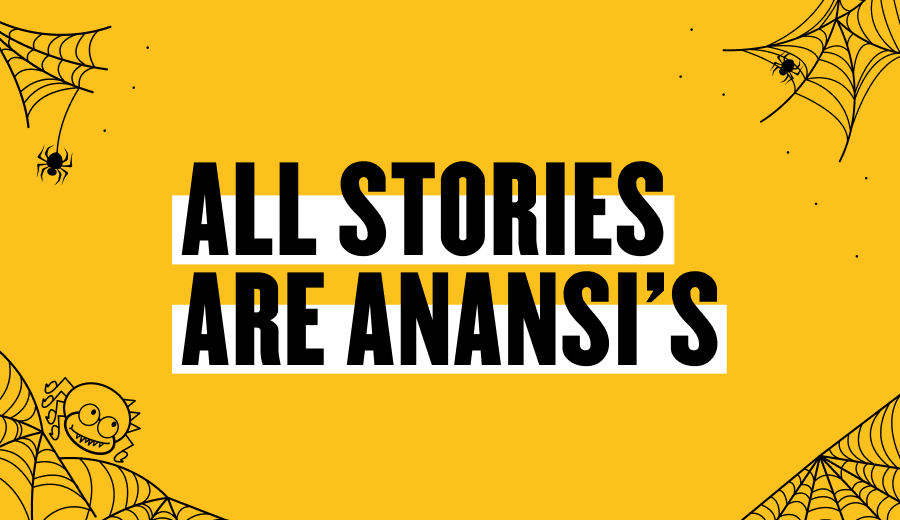
A Tale from Ghana
For this year’s #worldfolktalesandfablesweek2022, we bring you a tale from Ghana.
Although the Anansi tales originate from Ghana, variations of the tales can be found in other parts of West Africa, USA, and the Carribeans. The stories were carried across oceans and seas by enslaved Ghanians to the Americas and Caribbeans, and were passed down orally to other generations. Even though they have been removed from their homeland, these stories served as tether and enabled them to stay connected to their culture. Over time, the tales of Anansi were integrated into other cultural folktales of the new countries where they now lived, such as the Cherokee story of the “Tar Wolf”, or Mr. Nancy in the USA, the Br’er Rabbit originated from the folklore of the Bantu-speaking peoples of south and central Africa, and in the Carribeans. As such these stories have been preserved over time and generations, in many ways, names, and languages.
Like all cautionary tales, Anansi tales are meant to entertain but also instruct. We hope you enjoy it!
Anansi, the trickster, is a West African god, considered to be the god of all knowledge of stories. The Anansi tales are believed to have originated with the Ashanti people of Ghana. (The word Anansi is Akan and means, simply, spider.) Anansi is sometimes depicted as an ordinary spider with a human face, or conversely, a human with spider-like features. Anansi also has a family in several folktales involving him, consisting of his long-suffering wife Okonore Yaa –known in other regions as Aso, Crooky, or Shi Maria; Ntikuma, his firstborn son; Tikelenkelen, his big-headed son; Nankonhwea, his son with a spindly neck and spindly legs; finally, Afudohwedohwe, his pot-bellied son, and a beautiful daughter named Anansewa in other tales. Anansi stories are part of an exclusively oral tradition, and Anansi himself was seen as synonymous with skill and wisdom in speech. As a result, stories of Anansi became such a prominent and familiar part of Ashanti oral culture that they eventually encompassed many kinds of fables. Anansi is also known as Ananse, Kwaku Ananse, and Anancy.
Long ago, there were no stories on Earth. In those days all stories belonged to the sky god, Nyame, who kept them in a box beneath his throne. Because they had no stories to share, the people of Earth did not have much to do. Anansi the spider could see that the people were restless and bored. He decided he would bring them something that would help them pass the time. Anansi stretched his eight legs and wove a wonderful web that reached all the way to the sky. He climbed up the web until he arrived at the throne of the sky god, Nyame, the keeper of all stories. “Nyame,” Anansi said, “great, wise god of the sky—I would like to take the stories to the people who live on Earth. Will you let me have the great box where you keep the stories?” “I will give you the stories,” said Nyame, in a booming voice. “But the price is high. You must bring me three things: Onini, the great python who can swallow a goat; Osebo, the mighty leopard whose teeth are as sharp as spears; and Mmoboro, the hornet whose sting burns like a needle of fire, and the invisible fairy Mmoatia who was famous for her pride, greed, and quick temper”.“I will pay the price,” said Anansi.
Anansi made his way back down the web to Earth. He went to speak with his wife, Aso. Together, they came up with a plan to capture Onini, the great python who could swallow a goat. The next morning Anansi walked into the forest, waving a big branch. As he walked, he spoke to himself. “She’s wrong,” he said, pretending to be very upset. “I know she is. He is much, much longer than this branch.” As Anansi drew near the watering hole, a large snake rose up. It was Onini, “What are you muttering about, Anansi?” asked Onini. “You are disturbing my nap.” “I have been quarreling with my wife,” said Anansi. “She says that you are shorter than this branch. But I say you are longer. She will not listen to me, and I do not see how I can prove to her that I am right.” “That is easy,” said Onini. “Lay your branch on the ground and I will lie next to it. Then you shall see that I am longer.” The great snake slithered over and lay next to Anansi’s branch. “It looks like you may be longer,” said Anansi. “But I can’t tell for sure because you are not quite straightened out. Could I straighten you out a bit?” “Certainly,” said Onini. “Let me fasten your tail at this end,” said Anansi as he worked. “That way I can really straighten you out. And let me fasten you here, by your head, as well.” Before the python realized what Anansi was up to, Anansi had spun a web around Onini and tied him to the branch. “Now you are caught!” said Anansi. With that, Anansi carried Onini the python to Nyame. “That is one thing,” said Nyame. “Three things remain.”
Anansi went back to Earth and began to think about how he might catch Osebo, the mighty leopard with teeth as sharp as spears. Anansi dug a pit on the path Osebo used to get to the watering hole. He lay branches across the pit and covered the branches with sticks, leaves, and dirt. When Anansi was satisfied that the hole was well hidden, he scurried home and went to sleep. When Osebo came out to hunt during the night, he fell right into Anansi’s trap. Anansi found him down in the pit the next morning. “Osebo,” said Anansi, “what are you doing down in that pit?” “You fool!” said Osebo. “Can’t you see that I have fallen into a trap? You must help me get out.” “I will see what I can do,” said Anansi. Anansi found a large willow tree and bent the top of the tree over the pit. He spun two silky cords and used them to hold the tree down. Then he spun another silky cord. He attached one end of this third cord to the top of the tree and let the other end dangle down into the pit. “Tie this cord to your tail,” said Anansi. “Then I will lift you up.” Osebo tied the cord to his tail. Then Anansi cut the two cords that were holding the tree down. The tree sprang back to its original position, carrying Osebo with it. Osebo dangled from the tree. “Now you are caught!” said Anansi. Anansi wove a web around Osebo the leopard and carried him to Nyame. The sky god was impressed. “That is two things,” he said. “Two things remain.”
Anansi went back to Earth to catch Mmoboro, the hornet whose sting burned like a needle of fire. He cut a calabash from a vine and hollowed out the inside. Then he filled the gourd with water and went to the nest where Mmoboro the hornet made his home. Anansi poured some of the water in the gourd over his own head. Then he dumped the rest of the water on the hornet’s nest. Mmoboro the hornet came out, buzzing angrily. He saw Anansi standing nearby, holding a leaf over his head. “Oh, my!” said Anansi. “The rainy season seems to have come early this year, and it looks like you have no shelter from the rain. Would you like to take shelter in my gourd until the rain goes away?” “Thank you, Anansi,” said Mmoboro the hornet, as he flew into the gourd. “You’re welcome!” said Anansi, as he closed up the opening in the gourd with a leaf and wove a web to hold the leaf in place. “Now you are caught!” said Anansi. Anansi carried Mmoboro the hornet to Nyame. Nyame was very impressed. “That is three things,” he said. “Only one thing remains.”
The fourth and final creature for Anansi was Mmoatia, a crafty African fairy. Her favorite food was yams, so Anansi created Gum Baby, a doll made of gum, attached a web line to its head, and put a plate of yams his wife made on his lap. When Mmoatia came by, she asked for one, Anansi pulled the web line to nod yes. After Mmoatia ate the yams, she thanked the gum baby but it didn’t say or do anything back. Eventually Mmoatia got so angry, she attacked the gum baby with her hands and legs and got fully entangled. “Now you are caught!” said Anansi. Anansi carried Mmoatia to Nyame. “That is the last thing!” he proclaimed. Then Nyame called out, in a voice like thunder: “Listen to me! Anansi has paid the price for the stories of the sky god, and I do hereby give the stories to him.”
From this day forward, all of the stories belong to Anansi. Whenever someone tells one of these stories, he or she must acknowledge that it is Anansi’s tale.” Anansi took the box of stories back to Earth and shared them with the people. The people were grateful for the stories and told them to their children and to their children’s children, who told them to their children, and so on. Even to this day, these stories are known as spider stories.
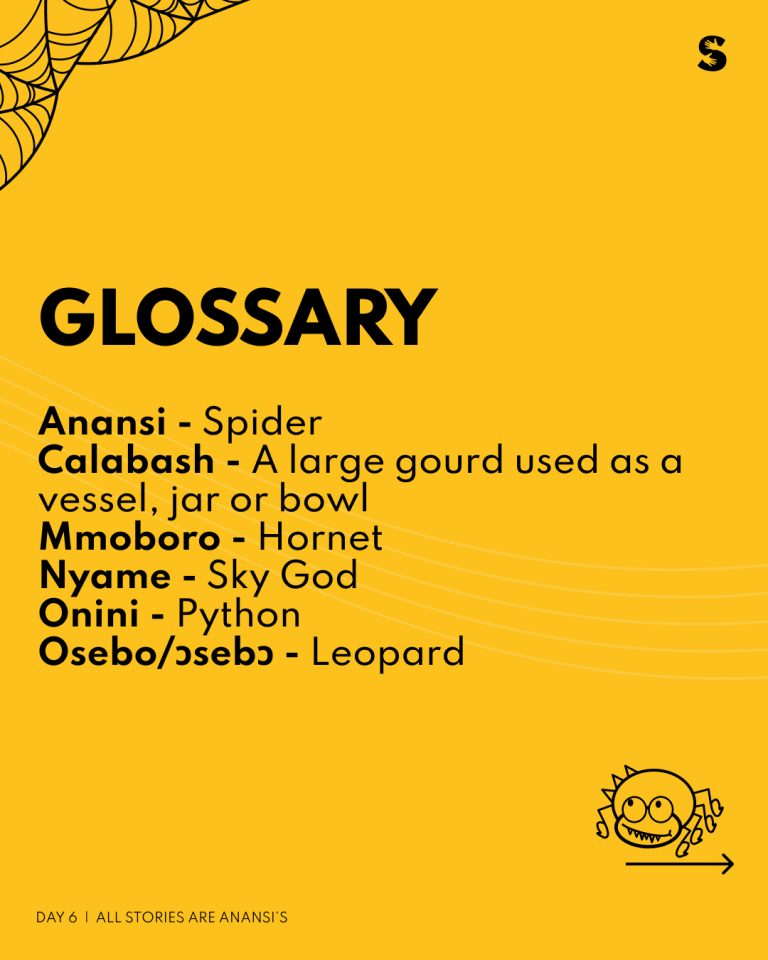
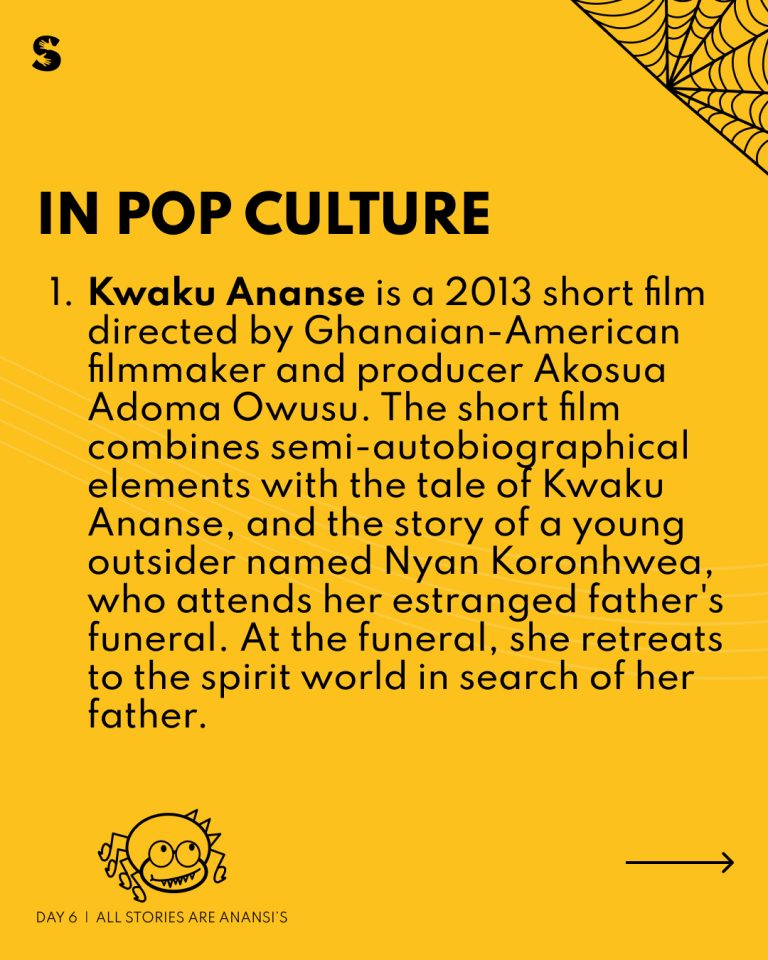
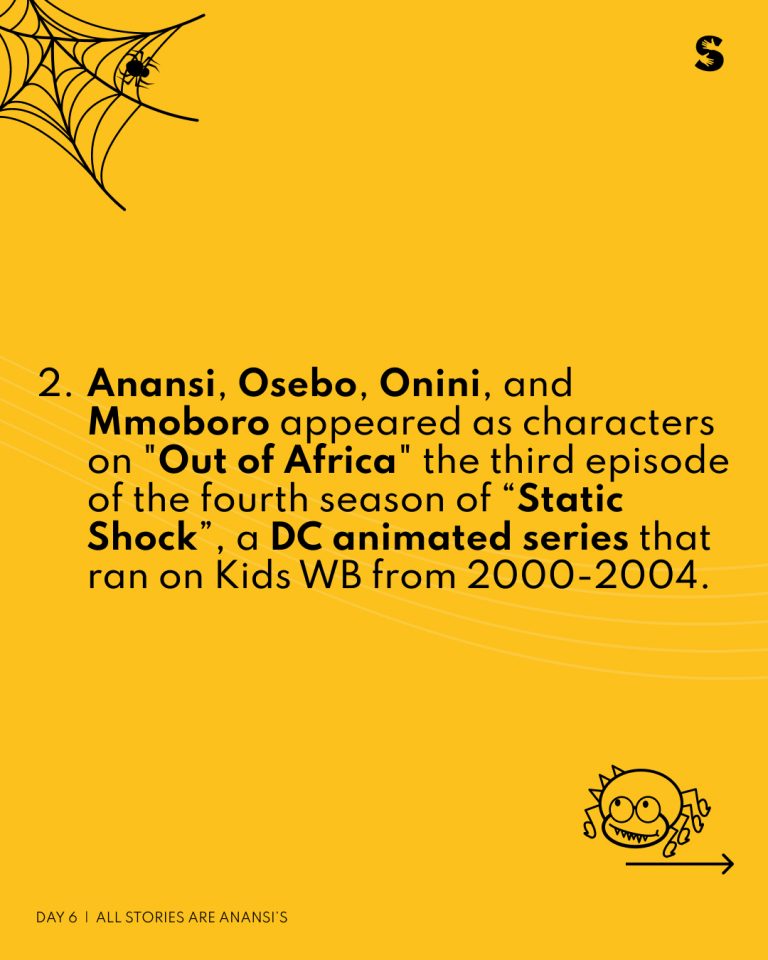
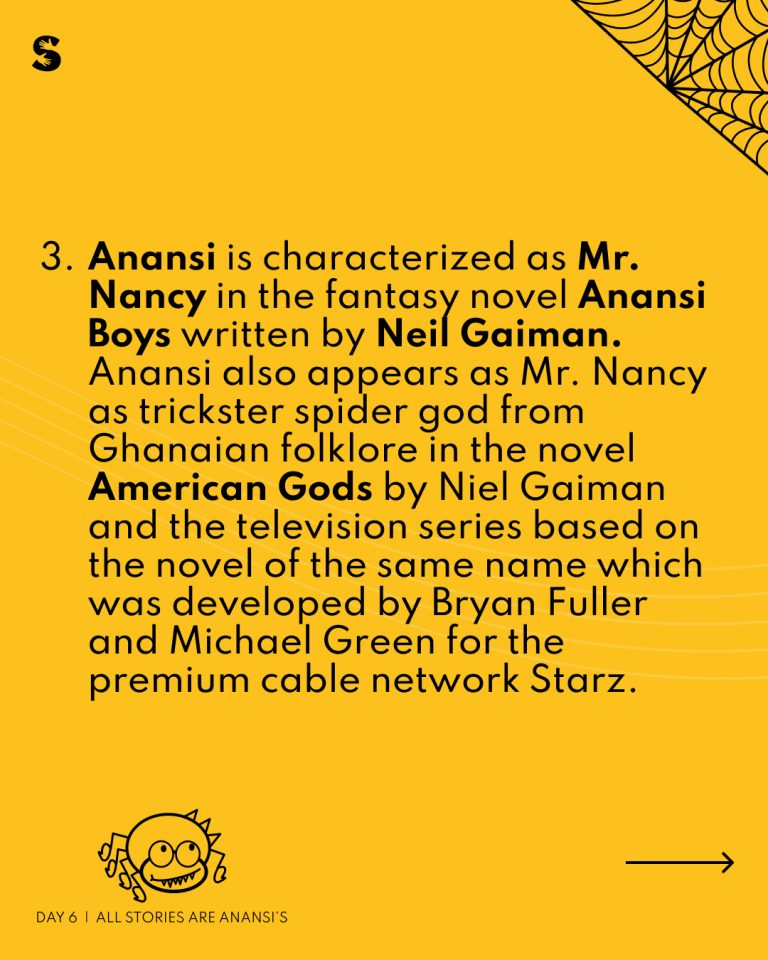
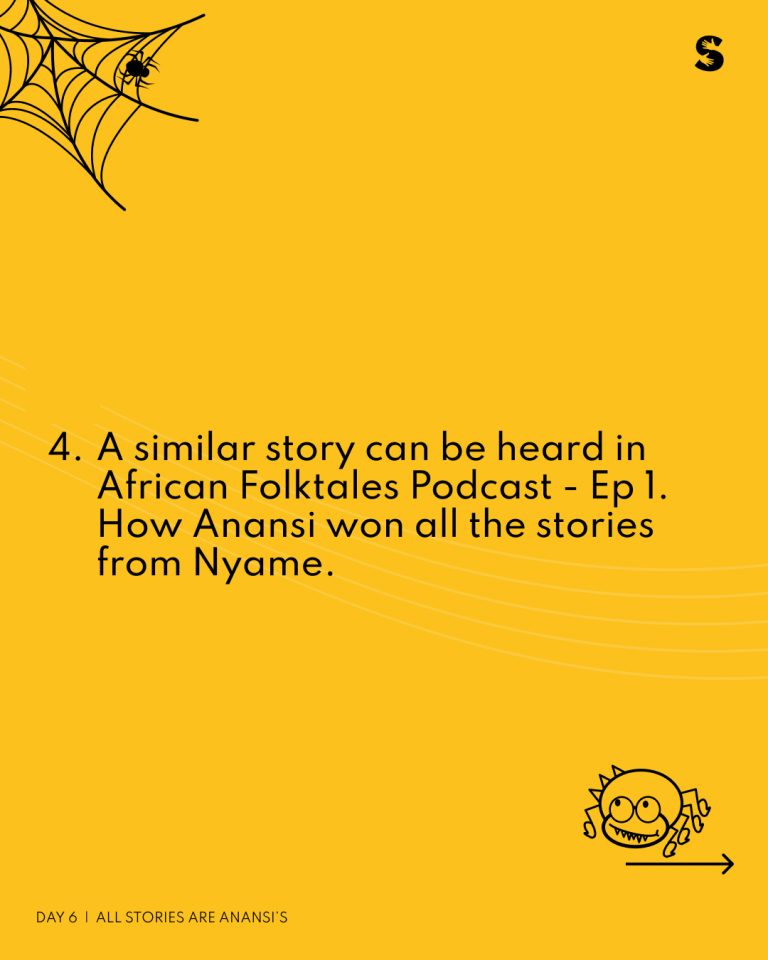
Sources
- https://dcau.fandom.com/wiki/Mmoboro
- https://dcau.fandom.com/wiki/Osebo
- https://dcau.fandom.com/wiki/Onini
- https://dcau.fandom.com/wiki/Anansi
- https://www.coreknowledge.org/wp-content/uploads/2019/07/G1_U1_ContinentsCountriesMaps_FE3_Anansi_FOR-PDF.pdf
- https://en.wikipedia.org/wiki/Anansi#cite_note-28
- https://en.wikipedia.org/wiki/American_Gods
- https://en.wikipedia.org/wiki/Akosua_Adoma_Owusu
- https://en.wikipedia.org/wiki/Kwaku_Ananse_(film)
Haley, Gail E. (1999). A Story a Story. Topeka Bindery. ISBN 0-88103-606-4.





